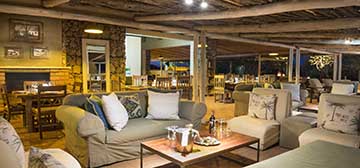
Andersson's at Ongava
- Etosha, NamibiaFamily-friendly Andersson’s Camp, named for Charles Andersson, the Swedish explorer who first described the Etosha Pan, takes the past and moves it decidedly forward.

Namibia is a vast dry land. One of the largest countries in Southern Africa, it is also one of the least populated. The country is bordered by South Africa to the south. Botswana to the east, Angola and Zimbabwe to the north and on its western edge, huge desert dunes sweep down to the cold South Atlantic Ocean. The country contains two vast deserts; the Kalahari in the east and the Namib in the west. The Namib is the world's oldest desert seeming parched and desolate and yet containing a surprising amount of plant and animal life.
The desert experience is unique in almost everyway. At times the silence and the solitude can seem overwhelming yet in places like Etosha National Park in the north of the country game is abundant and varied. A safari here is truly a treat for the soul.
Things to look forward to in Namibia:The rugged, rocky landscape is characterised by valleys and dry riverbeds that carve their way through deep gorges and ancient geological features.
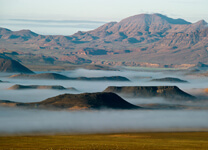
In the north of Namibia is Etosha, a national park approximately the size of Switzerland. Originally created in 1907, Etosha has become the premier game viewing area in Namibia. Dominated by a huge salt pan that remains dry most of the year, Etosha's game tends to congregate around the many water holes which dot it's perimeter. Etosha contains huge herds of plains game as well as abundant prides of Lion. It is also one of the only places in Africa where one can view both the Black and White Rhino.
Ongava Lodge and Tented Camp on the outskirts of the park provide a luxurious retreat amid the abundant game.
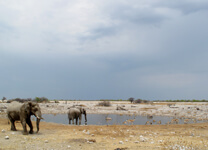
Named for the numerous shipwrecks which dot the shoreline, the Skeleton Coast stretches along the north west of Namibia where the vast Namib kneels at the breakers of the cold South Atlantic ocean. Huge colonies of southern Fur Seals, penguins gannets and the spectacular pink flamingoes drawn here by the abundant food contained in the frigid waters create a wildlife spectacle of awesome proportions. The seemingly lifeless desert is watered here by fog that blankets the coast from nightfall to dawn. The resulting moisture feeds plant life which attracts the Gemsbok or Oryx as well as herds of the smaller springbok and other antelope who make this arid land their home.
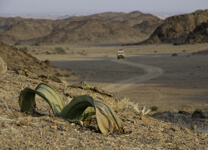
Unique in Namibia and in fact in the world, Sossusvlei is a huge clay pan hemmed in by giant sand dunes. Some of these incredible dunes rise almost a thousand feet out of the Namib Desert. They are in fact the highest dunes in the world. Rain is very scarce here but when it does fall, the clay layers hold the water above ground and a shallow lake forms. The lake takes on a turquoise hue and the land around the lake becomes carpeted with wild flowers of every imaginable color. The result is a riot of color and life in an otherwise desolate place.
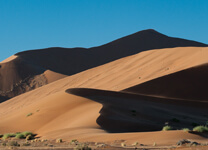
For a place that at first glance may seem lifeless, the reality is astonishing: 650 bird species and 80 large mammal species, of which, 14 birds and 15 mammals are almost entirely endemic to the country. Reptile species total 240!
In the far northern reaches of the Kunene, wildlife is concentrated around the Kunene River where a large population of Nile crocodile dwells. Moving south, the wildlife-rich Etosha National Park is home to high densities of game. To the west the Kaokoveld’s dry, remote and isolated wilderness boasts desert-adapted wildlife: good elephant populations as well as giraffe, lion and brown hyaena amongst others. It is in this area that the largest free-ranging population of black rhino in Africa survive. As one moves further south, densities of large mammals are lessened, but do not disappear. Plains game such as springbok, gemsbok, wildebeest, Burchell's zebra, Hartmann's mountain zebra, waterbuck, red hartebeest, giraffe, eland and endemic black-faced impala are seen.
Namibia is the fifth largest country in Africa whose western border is the Atlantic Ocean. It shares land borders with Angola and Zambia to the north, Botswana to the east and South Africa to the south and east.
Summer in Namibia is hot, but there is no better way to experience the season than seeing the dark clouds of an approaching thunderstorm which contrasts with the bleached calcrete soils waiting to be replenished. Late summer sees the ideal 'green desert' with a profusion of colour and life in the form of wildlife, grass and flowers. Conditions are definitely warm, with daytime temperatures reaching around 40° Celsius (albeit a drier heat) and milder evenings. The mornings are exceptional thanks to the beautiful light and calm conditions, perfect for warm pre-dawn starts to the day. For the photographer this is a special time: breathtaking horizons, dramatic light and lightning displays, fresh clean air with towering cloud formations, and visibly more energetic game.
It’s also the best season for birding. Many special resident species breed at this time, such as Rüppell’s parrot and white-tailed shrike, and these are complemented by the arrival of migratory species – both intra-African and Palearctic.
This is a time of moderate climate, combining the best of the green and dry seasons. By May, temperatures start to cool, while November brings the heat of summer – as well as the arrival of many summer migrant bird species.
This is a cooler and drier time of the year with cool to cold nights and warm days. Daytime temperatures begin rising towards September, with October generally being hot.